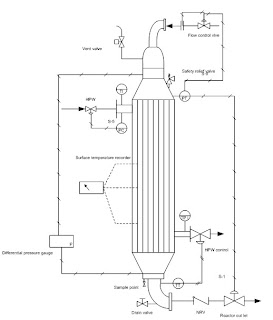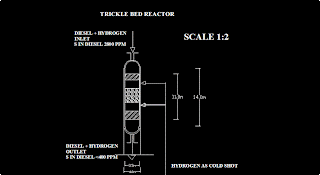For conducting gas-phase chemical reactions in presence of a catalyst a shell and tube reactor is best to suit if heat transfer plays important role in the chemical reaction conversion. In the case of an exothermic reaction, heat evolves as the reaction proceeds producing products from the reactant, if this heat is removed then the forward reaction is continuous because the temperature of the reaction mixture is maintained constant at the operating design temperature. If the heat is not removed and so it leads to an increase in the temperature of the reaction mixture due to the accumulation of heat and when this reaches the activation energy barrier of a backward reaction then the reaction ceases and the product does not form. Similarly, for endothermic reactions, heat is to be supplied continuously to make the reaction proceed forward, and we have to supply the activation energy. This reaction mechanism demands better heat transfer designed a reactor that can be used with catalyst holding, loading, and maintenance free, and can easily be operated and controlled. A design in the form of a shell and tube heat exchanger where the tube acts as a plug reactor packed with catalyst and shell the heating or cooling media are used for heat exchange purposes.
The main drawback of shell and tube reactors is that they are not so good for liquid reactions, but efficient for gas phase catalytic reactions.


How to remove scale formation in water pipes, used in House utility
Pipes that are used regularly for in-house utility are made of PVC, Galvanized steel, or even alloy metals, for using water at various locations these pipes are inbuilt during the construction of the house, they may pass around a circuit from a header tank to all the taps, but we come across a problem of less pressure water and even face a situation of chocking in the pipe which so the water do not flow sufficiently. When we use groundwater for our utilities, it contains some salts which are dissolved in it, during the course of time these salts start to deposit on the surface of the pipe which they flow along with the water, in most cases pipes which are exposed to the sun will make high deposition of this scale and decrease the diameter of the pipe leading to poor performance. The scale has the composition of calcite which is formed from calcium carbonate present in the water.

We call a plumber and spend huge money on maintenance and repair work. Rather we can do simple stuff which costs very less and is easy to clean the pipes. By using hydrochloric acid mixed with the water we can remove the scale formation in the pipe. The cost of diluting HCl is less and it doesn’t harm much when compared with other chemicals, all safety precautions should be followed and but this can be used for PVC pipes only, not for metal pipes there are some other chemicals used as per the material of construction of the pipe. Based on the scale composition there are effective chemicals that can easily dissolve and remove the scale from the pipe surface, for example, calcium carbonate scales can be dissolved by using a 5 – 10% HCl dilute solution, calcium sulfate scales can be dissolved by adding EDTA (ethylenediamine tetraacetic acid), with which they form a soluble complex and the quantity depend on the amount of scale deposited let’s take for the scale of 1 mm thickness it takes 2- 5% solution of EDTA.
To remove scale formation in the water pipe made of PVC just mix some HCl in the water storage tank and circulate the water for 1 hr so that it dissolves all the scale and cleans the pipe. By doing this you save money and time and increase the lifetime of the water circuit system. Finally, after cleaning, drain all the water and fill the water tank with fresh water now circulate it so that it removes the traces of HCl and makes your piping system ready for regular use. You can check the pH with litmus paper and make sure it appears to be 7 which is a neutral condition and safe to use.





